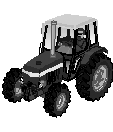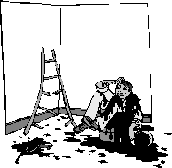Spinal Cord Injury - Student Reference Sheet
Spinal cord injuries are some of the most severe injuries in the agricultural industry, and can cause paralysis and even death. A single cause of spinal injuries cannot be pinpointed because factors such as carelessness, fatigue, equipment, speed, time, and use of safety measures each play a role. Spinal cord injury on farms usually happen because of tractor overturns, falls, and all-terrain vehicles (ATVs).
 Tractors
play a major role in death and injury among farmers. Incidents
include being pinned beneath an overturned tractor, running
into or over something, falling from the tractor, or the tractor
rolling over with the operator. Being thrown from the tractor
greatly increases the chances of spinal injury. A survey of
Kentucky farmers showed that one of every nine farmers had
rolled a tractor at least one time. Other situations can lead
to injury as well, such as having extra riders on the tractor
or starting the tractor from the ground (bypass starting).
Tractors
play a major role in death and injury among farmers. Incidents
include being pinned beneath an overturned tractor, running
into or over something, falling from the tractor, or the tractor
rolling over with the operator. Being thrown from the tractor
greatly increases the chances of spinal injury. A survey of
Kentucky farmers showed that one of every nine farmers had
rolled a tractor at least one time. Other situations can lead
to injury as well, such as having extra riders on the tractor
or starting the tractor from the ground (bypass starting).
Many spinal cord injuries result from other sources on the farm. Simple daily and seasonal work such as painting, repairing roofs, hanging tobacco, and farm maintenance chores can result in spinal injury. Falls frequently result from slipping because of poor traction or not wearing suitable shoes when climbing. Climbing on unstable surfaces, like temporary rails or ladders, often results in falls as well. You don't have to be up high to be injured, though! Falls from as low as three feet can result in spinal injury.
All-terrain
vehicles (ATV's) are still another source of injury on the
farm. Improper operation of ATV's including high speeds, covering
rough terrain, venturing into unknown areas, going into impassable
areas, and going up steep slopes leads to injury when the
operator and riders are not protected. Head injuries from
ATV crashes can cause neck damage that results in paralysis.

The medical
expense of a spinal cord injury alone is more than most people
in agricultural occupations can afford, not to mention all
the other costs the injured person and their families suffer.
Usually a recovery period is required (longer time for the
more severe injuries) in which the injured person is unable
to perform farm tasks that need to be done. This results in
missed profits, reduced returns, and added expense of hiring
labor. Imagine if you fell from a tobacco barn, hurt your
back, and had ten more acres of tobacco that needed to be
cut and put in the barn. You have to pay your medical bills
and pay someone to house the crop.
 There are additional costs when a person has a spinal injury.
So many things we take for granted can no longer be done as
before, and sometimes cannot be done at all. Recreational
activities like playing ball, boating, hiking, swimming, and
fishing can be hindered by a spinal injury. New activities
like therapy, exercise, and medications become a part of the
daily routine. Little things like getting dressed in the morning,
brushing your teeth, and taking a shower have to be done in
a new way and sometimes require assistance. Persons with paralysis
may need catheters for emptying their bladders and must retrain
their bowels to function. Special exercises must be done to
prevent muscle deterioration and deformities. It is hard work
to live with a spinal injury.
There are additional costs when a person has a spinal injury.
So many things we take for granted can no longer be done as
before, and sometimes cannot be done at all. Recreational
activities like playing ball, boating, hiking, swimming, and
fishing can be hindered by a spinal injury. New activities
like therapy, exercise, and medications become a part of the
daily routine. Little things like getting dressed in the morning,
brushing your teeth, and taking a shower have to be done in
a new way and sometimes require assistance. Persons with paralysis
may need catheters for emptying their bladders and must retrain
their bowels to function. Special exercises must be done to
prevent muscle deterioration and deformities. It is hard work
to live with a spinal injury.
The
good news is that spinal cord injuries in agricultural occupations
can be prevented. The key ways to prevent them include:
This curriculum guide was supported by Grant Number 1 R01/CCR414307 from NIOSH. Its contents are solely the responsibility of the authors and do not necessarily represent the official views of NIOSH. Special thanks to Dr. Ted Scharf.
Disclaimer and Reproduction Information: Information in NASD does not represent NIOSH policy. Information included in NASD appears by permission of the author and/or copyright holder. More